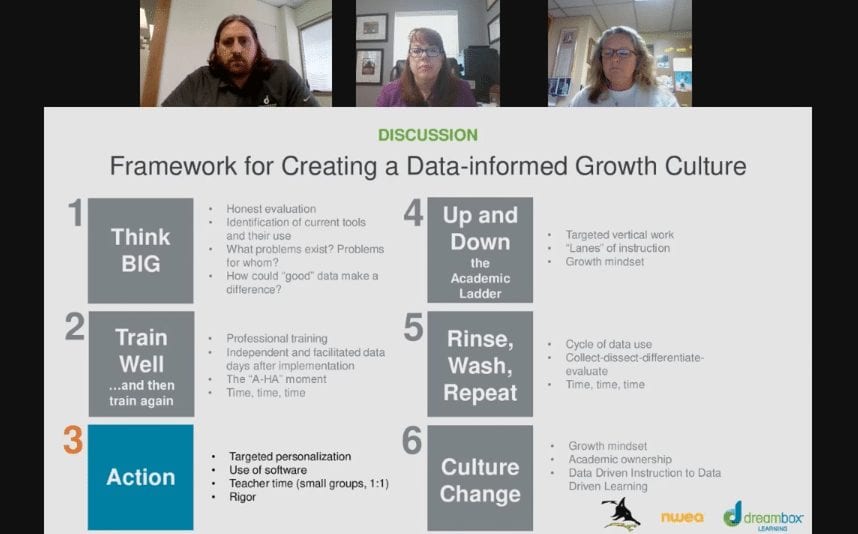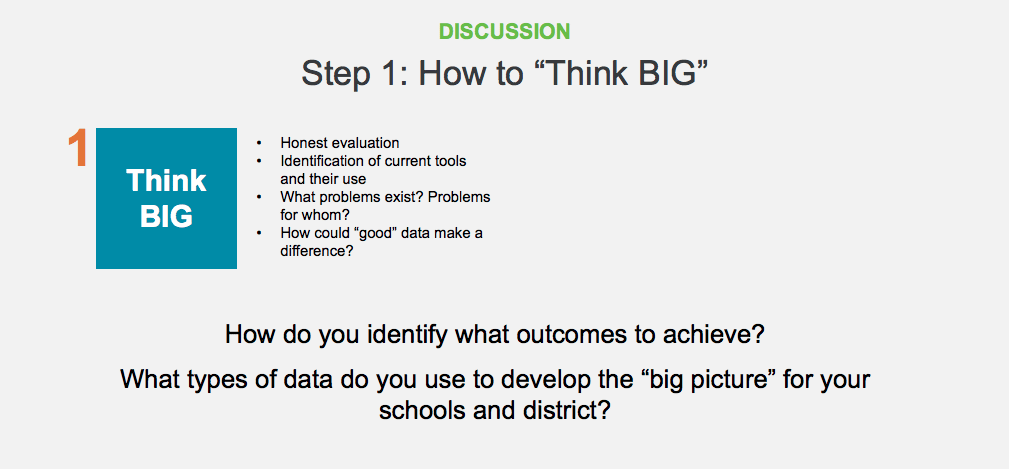Data-driven learning, not instruction, is the future of education
Data-driven instruction may be the popular catchphrase in education, but in a recent edWebinar, the speakers advocated for data-driven learning. The student, they said, should be at the center of all educational efforts, especially when the goal is to improve outcomes. “Using Student Learning Data to Foster a Growth Culture,” featuring Amy Trees Dodson, M.Ed., Director of Instruction, Cisco Independent School District (CISD), TX; David Woods, Director of Curriculum and Reporting, DreamBox Learning; and Robyn Sturgeon, Professional Learning Consultant, NWEA, focused not just on the idea of collecting data, but on only collecting the data that is actionable. Instead of teaching to the middle, they said, educators and students can use data to attack learning.
Using the CISD framework as an example, the presenters discussed six key phases for developing buy-in and creating a successful data-oriented learning system.
Phase 1 – Think Big: First, schools and districts need to do an honest evaluation of their programs. What assessments do they use now? What data do they have, and what are they missing? What problems exist where more specific data would be helpful? This is the opportunity for stakeholders to brainstorm about how they can use data to make a difference.
Phase 2 – Train Well…and then train again: While professional development seems like an obvious step, the speakers emphasized that this is a never-ending process. Although some training can be done in large groups, most should be small group work, possibly even one-on-one. Here, teachers need to understand that what gets assessed gets discussed and learn how to incorporate the information into their lesson plans.
Phase 3 – Action: The point of using data to drive learning is to change what is happening in the classroom. Without action, it’s meaningless. In addition to the teachers looking at the data, students benefit from understanding their own performance. When developing student improvement plans, however, don’t make time the constant and limit how long students have to learn a concept or make progress, commented Woods. In data-driven learning, time is the variable and achievement is the constant, which keeps the focus on individual student success.
Phase 4 – Up and Down the Academic Ladder: Data shouldn’t stay in the silo of the classroom or even the grade. Looking at data across grades and schools can show where the gaps are and inform larger instructional changes. Educators shouldn’t just be looking at students performing below grade level, though. High-performing students can have gaps too and need help to reach their potential.
Phase 5 – Rinse, Wash, Repeat: Data collection, interpretation, and action are never done. Schools need to continually evaluate what they are collecting, how they are using it, and its impact on achievement. Again, they need to check in with the students to make sure that the students are seeing the value as well.
Phase 6 – Culture Change: As schools cycle through the different phases, teachers, parents, and students need to feel ownership of the process and how the data is used. When all constituents share this growth mindset, you’ll see overall positive changes across the community.
Finally, as schools begin using data, they should think about how it can impact students now—not in the future. End-of-year assessments are like autopsies, said Trees Dodson, because they can’t help those who’ve moved on.
This broadcast was hosted by edWeb.net and sponsored by DreamBox Learning.
This article was modified and published by eSchool News.
About the Presenters
Amy Trees Dodson, M.Ed. is in her eighth year as an administrator at Cisco ISD, a small rural district in West Central Texas. She supervises instructional support, libraries and research, and media among other responsibilities. She leads the Elevate Blended Learning program which was selected as a state-wide demonstration site by the Raise Your Hand Texas foundation and as a national model by The Learning Accelerator. Prior to joining CISD, Amy spent 18 years in higher education serving as a member of the teaching faculty and as an academic administrator at both the four-year and two-year level.
At every level of educational work, Amy has focused on student success and on increasing academic achievement with students. She founded centers and programs for academic success and support at two colleges and taught success and leadership classes. She also co-authored a textbook for students entering college which was designed to assist students in reaching their potential both inside and out of the classroom. At K-12 she works closely with teachers across disciplines and grade levels to support their classroom efforts, engage students, and identify ways to raise outcomes. Both her belief that great teaching empowers students and her extensive experience focusing on individual student success have ignited Amy’s passion for blended and personalized learning. She brings to the panel a unique perspective on the implementation and sustainability of a systemic, radical paradigm shift within traditional, public education in Texas.
David Woods earned a BA in elementary education with endorsements in reading and middle level mathematics and a minor in Spanish from Whitworth University, and a Master’s Degree in integrating technology in the classroom from Walden University before joining the DreamBox Curriculum team. Throughout his teaching career, David reviewed new curriculums, interpreted assessment data, and was a leading member of his professional learning community of math teachers. For the last six years he has been a curriculum designer at DreamBox Learning, currently serving as the director of curriculum and reporting, where he can apply his passion for building an effective, individualized math curriculum.
Robyn Sturgeon has over 23 years of experience as an educator, coach, and administrator. She began her career in the classroom and taught for 13 years as a classroom elementary teacher for grades K–5. She has also served as a curriculum coach and as an assistant principal in preK–8 schools. In addition, Robyn’s role as an assessment specialist included working with all 23 schools in her district to help administrators, coaches, and teachers use MAP® assessments and data to increase student achievement.
Join the Community
Leadership 3.0 is a free professional learning community where school and district leaders collaborate on innovative strategies to help teachers grow professionally, advance student learning, and improve communications with all stakeholders.






Comments are closed.